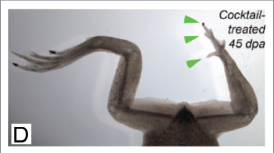Review: Electric shock
Posted by Eva Amsen, on 7 February 2013
Last year, Matter launched, after a successful Kickstarter campaign, as a magazine that publishes only long, well-written articles related to “science, technology and the ideas shaping our future”. Each issue is one article, which costs $0.99 to access. (On my iPad, they ‘re categorized as books, and are each about 40 pages long, which I think justifies both the price and the fact that I’m filing this under “book review”.)
The latest issue is of Matter is about online scammers, but the one before that was about developmental biology! Or rather, “Electric Shock”, written by Cynthia Graber, is about a biologist. It profiles the life of Michael Levin and his work in understanding the role of bioelectricity in organ regeneration.
Matter’s audience is broad, and most of them are not biologists, so when Graber describes Levin’s work, she also has to explain the basics of developmental biology: “One cell divides into two, two into four, four into eight, continuing until there are dozens, thousands, millions of them. In the process, some cells transform into blood, others into bone; some into tissue, others into tendon.”
 The specific work described in the article is a study published in Communicative and Integrative Biology last month, as an addendum to an earlier paper from the Levin lab in The Journal of Neuroscience. Their earlier work had shown that tadpole tails can regenerate in response to regulated ion transport, and that bioelectric signals can induce ectopic eyes in tadpoles, but now they also achieved regeneration in (older) developing frogs’ legs!
The specific work described in the article is a study published in Communicative and Integrative Biology last month, as an addendum to an earlier paper from the Levin lab in The Journal of Neuroscience. Their earlier work had shown that tadpole tails can regenerate in response to regulated ion transport, and that bioelectric signals can induce ectopic eyes in tadpoles, but now they also achieved regeneration in (older) developing frogs’ legs!
In “Electric Shock”, Graber describes not just the work itself, but the context. Why did Levin become interested in bioelectricity? What was he like as a child? How does he spend his time outside of the lab? We learn that Levin takes his parents to Florida each year, for a few weeks in March. He brings along a lot of reading material on those trips, to think about his work from new angles, and discusses it with his family. “…at night, he explains his thoughts to his father over dinner. “If I can’t explain my ideas to a very smart non-expert then I haven’t really fleshed them out properly anyway,” he says.””
I love reading profiles of researchers that go beyond what’s in the scientific literature. In this case, I was especially amused because the very week that this issue of Matter came out, we also published one of Levin’s papers in Development, so he was suddenly everywhere! His most recent Development paper was about planarian regeneration, which wasn’t covered in the Matter piece, but we also published the frog ectopic eye work last year, and it was great to get a glimpse into the lab where the work was done.
Read the original article:
Electric Shock – by Cynthia Graber
Papers mentioned in this review:
Tseng A. & Levin M. (2013). Cracking the bioelectric code: Probing endogenous ionic controls of pattern formation, Communicative & Integrative Biology, 6 (1) e22595. DOI: 10.4161/cib.22595
Tseng A.S., Beane W.S., Lemire J.M., Masi A. & Levin M. (2010). Induction of Vertebrate Regeneration by a Transient Sodium Current, Journal of Neuroscience, 30 (39) 13192-13200. DOI: 10.1523/JNEUROSCI.3315-10.2010
Beane W.S., Morokuma J., Lemire J.M. & Levin M. (2013). Bioelectric signaling regulates head and organ size during planarian regeneration, Development, 140 (2) 313-322. DOI: 10.1242/dev.086900
Pai V.P., Aw S., Shomrat T., Lemire J.M. & Levin M. (2012). Transmembrane voltage potential controls embryonic eye patterning in Xenopus laevis, Development, 139 (2) 313-323. DOI: 10.1242/dev.073759
(Disclaimer: I contributed to the Matter Kickstarter campaign and as a result I am on their massive editorial board and get to be part of crowdsourced topic suggestions for the magazine. However, I was not involved in commissioning this piece, and was as pleasantly surprised as anyone to suddenly find a profile of a developmental biologist in a broader media publication!)


 (7 votes)
(7 votes)